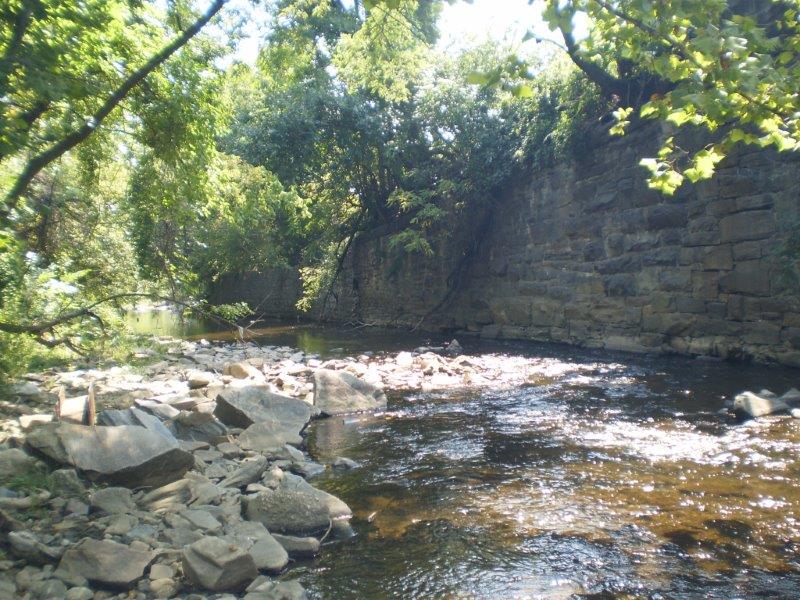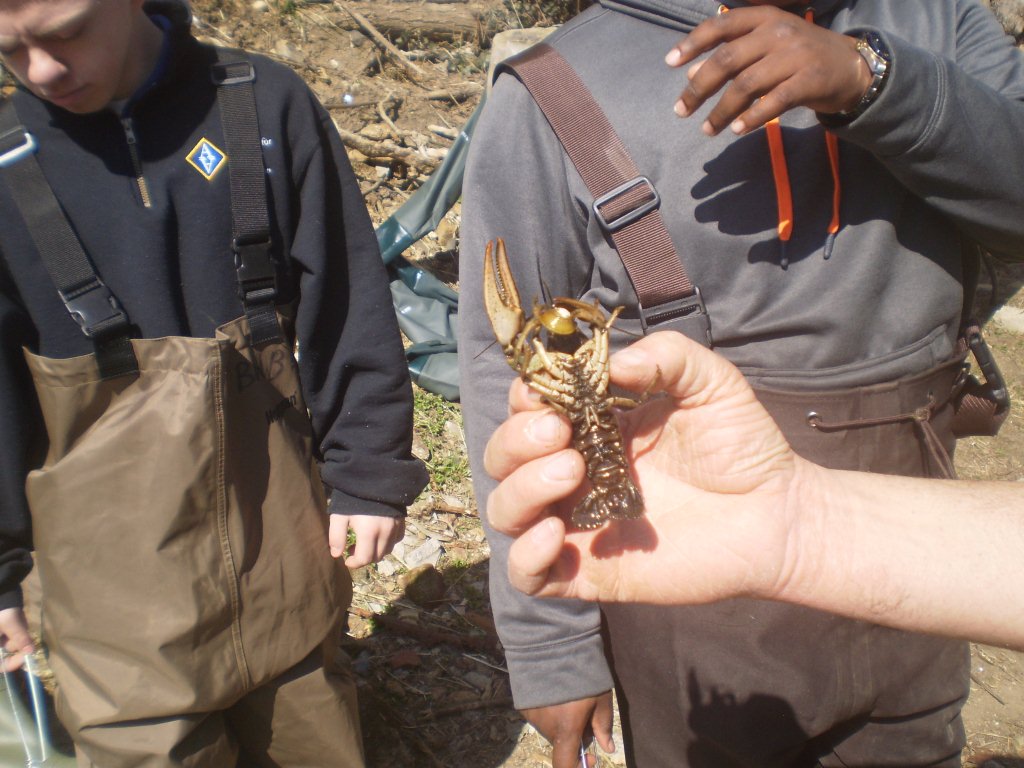Electrofishing with ACCE students at Mill #1
A northern hogsucker fish collected at Mill #1
A rusty crayfish from Mill #1 – note the Asiatic clam clamped onto its walking leg!
On Wednesday, April 1st at the Mill #1 complex on Falls Rd., we had the first of several stream studies with area high schools. We plan to hold four such events on the Jones Falls as part of our EPA grant. And boy did we luck out with the weather. Thank goodness Mother Nature did not decide to play an April fool’s joke on us, as it was 50-60 degrees F and sunny out the entire day. We (Lisa DeGuire from Blue Water Baltimore and I) had eight enthusiastic students from Mr. Moeller’s Environmental Issues class from ACCE to help out, and by the end of the day we knew quite a bit about this stretch of the stream that we did not know before.
Mill #1 is one of the repurposed mill complexes in the Jones Falls Mill corridor. It is located right at the last bend of Falls Road as you come south out of Hampden and descend into the Jones Falls valley itself. The building itself is really remarkable and has been converted into residences and office space in what is really a unique place in Baltimore, as you are literally right on top of a beautiful stretch of the Jones Falls. The facility is managed by Jennifer Nolley, who graciously agreed to allow us to use the building as a base for the stream study. I had never samples this particular interesting stretch of the Jones Falls, so I was just as excited as the students to see what kinds of things we could find. Our stream walk programs involve investigations into the fish, invertebrates and water quality of an area with the idea of assessing the stream health. Fish and invertebrates are tallied and recorded and noted as being generally identified as pollution tolerant, pollution intolerant, or having moderate levels of pollution tolerance. From these general traits we can get an idea of how the stream is doing. Looking at thes organisms is one of the best ways for us to get an idea of this, as they have to live there all year round. If you only come a couple of days a year and take water quality samples, you might miss measuring the important variable or just not be there on the right (wrong?) day. For that reason, looking at the things living in the stream gives us a much clearer picture of how things are going.
In order to sample fish we used electrofishing (pictured above) and we set minnow traps. Electrofishing uses an electrical current which momentarily stuns the fish, which can then be scooped up and put in the bucket. Captured fish typically recover in a matter of minutes and can be returned to the stream unharmed. The minnow traps we used are barrel shaped wire cages in which bait can be placed. As with a crab pot, fish can find their way in but can’t find their way back out. Using these two methods produced a nice list of species : Redbreast sunfish, northern hogsucker, satinfin shiner, tessellated darter, cutlips minnow, green sunfish, longnose dace. All of these species are what you would expect to find in streams with clear water, moderate gradient, and rocky bottoms in Maryland. One other interesting point is that all of the fish we looked at were native species, except one (the lone green sunfish we found). It is interesting to think that even with all of the changes that have occurred in the Jones Falls, these fish are for the most part probably the descendants of fish that lived here thousands of years ago. Another surprise was the number of northern hogsuckers collected in the sample. Research by myself and others has shown that when watersheds get urbanized like the Jones Falls, this is one of the first species to either disappear or get severely reduced in number. They are a species that require clean gravel and sand to build their nests, and this habitat tends to get negatively affected by the frequent and extreme high flows in urban streams. In streams that are less urbanized they are a familiar sight in the clear and shallow riffle areas, identifiable by the dark, tiger- like stripes on their backs. I had actually seen them before further downstream, but in small numbers. To find an apparently healthy population in the Jones Falls is a good sign indeed. It won’t be long until this species begins spawning as the water warms up, and this might be a good area to observe this behavior.
Another fun fish to talk about with the students was the cutlips minnow, which also makes the list for species that are sensitive to urbanization in this area. This species gets its name from a prong on its lower lip which it uses like a tool to get food items off of rocks and such. I haven’t seen it myself but I have read that it can use this same process to pop the eyeballs out of other fish it is put in aquariums with, called ‘eye-picking’ behavior! One final note is that out of all of these fish, really it is only the green sunfish which is noted to have a high tolerance to pollution. How does this fact couple with the fact that the Jones Falls has an extremely urbanized watershed? I can speculate that there may be a certain resilience that is present in streams like the Jones Falls, which are rocky, have always experienced high flows, and can flush themselves out naturally. Research has shown that some ecosystems appear to be more resilient than others to the effects of urbanization. Also, even as there are still serious issues with urban watersheds like the Jones Falls (bacteria, trash, high flows), we can recognize that our efforts to clean up the environment have not been in vain. Not by a longshot actually! It’s hard for us to perceive the improvement in water quality when it has taken place over decades, not years. The class at the end of the day came to a similar conclusion, in that there are things that are positive and those that are of concern about the state of the Jones Falls. While we also examined invertebrates and water quality, I will explain more about those in my next post about our stream studies!



